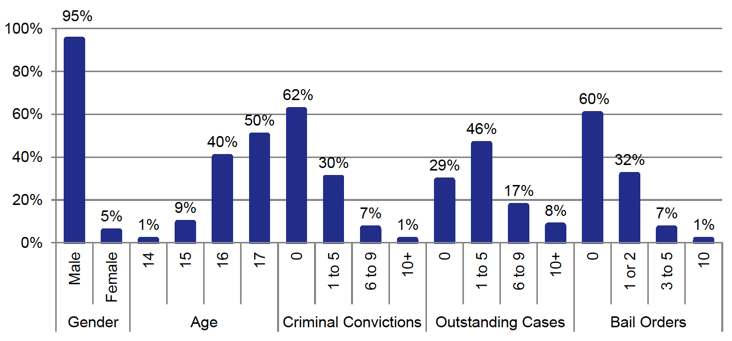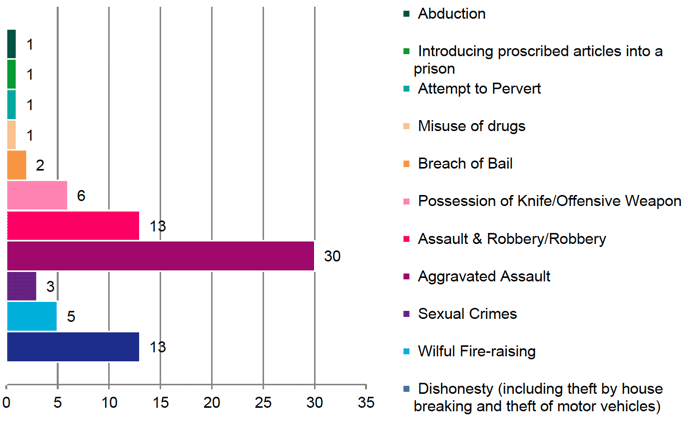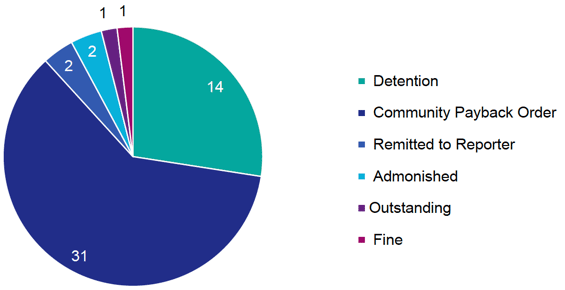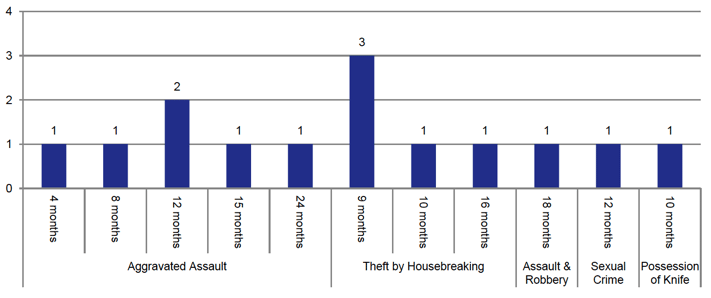Prosecution of young people: report
The Inspectorate of Prosecution in Scotland's thematic report on the prosecution of young people in the Sheriff and Justice of Peace courts.
Chapter 4 – Solemn Proceedings
"The more serious the deeds the more deep-seated the needs."[103]
198. In accordance with the Lord Advocate's Guidelines, all offences which require to be prosecuted on indictment[104] or are so serious they will normally give rise to solemn proceedings (in the Sheriff or High Court before a jury) should be jointly reported.
199. In 2016/17, 369 young people were placed on petition.[105] We examined 72 cases involving 76 offenders. Four were female and 72 were male.
Profile of Young People
200. Chart 5 provides a profile of young people placed on petition by gender, age, criminal convictions, outstanding cases and whether they were subject to bail orders.
Chart 5

Characteristics[106]
- 95% (72) of young people placed on petition were male
- 90% (68) were aged 16 or 17
- 62% (47) had no criminal convictions
- 71% (54) had at least one outstanding criminal case
- 25% (19) had more than five outstanding cases
- 40% (30) were subject to a bail order
- 8% (6) were subject to more than two bail orders. In three of the six cases, the offender was subject to 4, 5 and 10 bail orders respectively.
201. There were only seven (9%) offenders that had no criminal convictions, outstanding cases or any previous involvement with the Children's Hearing System and/or the police/COPFS.
202. Of the 76 offenders:[107]
- 20% (15) had offence grounds accepted or established with the Reporter.
- 15% (11) were subject to a CSO or had an open referral with the Reporter.
- 36% (27) had been given one or more alternative disposal by the prosecutor or police warnings or fixed penalties.[108]
Nature of Offences
203. Chart 6 provides a breakdown of the offences where young people were placed on petition:
Chart 6

204. The offences fall into the following categories:
- Offences so serious they will normally give rise to solemn proceedings, including abduction, assault and robbery, aggravated assaults, sexual crimes, offences of being concerned in the supply of Class A drugs, wilful fire-raising, attempting to pervert the course of justice through witness intimidation and introducing proscribed articles into a prison;
- Offences where, for public policy reasons, there is a presumption that they will be prosecuted by solemn procedure, including housebreaking of residential premises, possession of a knife in certain circumstances or locations and wilful fire-raising; and
- Breaches of bail conditions where the bail order was imposed in relation to a solemn matter and/or associated with the original offence.
Crown Counsel's Instructions (CCI)
205. No proceedings may be commenced against a child aged 12 years or more and under 16 years without the instruction of the Lord Advocate or Crown Counsel.[109]
206. Of the eight cases involving young people under 16 years, CCI was not obtained in three:
- In one, involving a 15 year old offender, contrary to COPFS guidance, CCI was not obtained before the decision to seek a petition warrant. By the time the offender was arrested and appeared in court, a month later, he had turned 16.
- In two cases, where CCI was not obtained, the offenders were 15 when the police reports were submitted. Both had intervening 16th birthdays – 13 and 33 days after receipt of the police report – prior to the cases being considered. Decisions to prosecute were taken approximately five and seven months after receipt of the report.
207. Whereas COPFS guidance provides that CCI must be obtained for any child under the age of 13 at the time of the offence, it is silent on when it should be obtained for a child aged 13, 14 or 15.
208. We found a lack of clarity on whether the age requiring CCI relates to the age of the child at the date of the offence (excluding historical crimes); when the police report is submitted; or when the initial decision to prosecute is taken.
Recommendation 11
COPFS should clarify whether the applicable age requiring CCI, prior to any proceedings being commenced for children aged 13, 14 or 15 years, is the age of the child at the date of the offence, when the police report is submitted or when there is a decision to prosecute.
209. Regardless of when CCI is required, cases involving children need to be prioritised. Otherwise delays at the reporting and decision-making stage, particularly for those aged 15 at the time of the offence but who may turn 16 by the time a decision on how to proceed is taken, has the potential to frustrate the intention of the statutory safeguard.[110]
"Serious offending is associated with victimisation and social adversity."[111]
Information on Vulnerabilities or Family Circumstances
210. The Edinburgh Study of Youth Transitions concluded that justice for victims and communities cannot be delivered unless the broader needs of young people are addressed. Many young offenders who have committed serious crimes have experienced trauma in their formative years and/or have complex needs and present a risk to themselves and to others.
211. Of the 76 offenders, information on vulnerabilities or family circumstances was provided in 27 (36%) police reports.
212. Of the eight offenders under 16 years, vulnerabilities were recorded in five (63%) police reports – three had extensive involvement with social work services, one was a looked after child and two had issues with drug or alcohol misuse.
213. There were four offenders aged 16/17 years subject to a CSO. None of the police reports disclosed any vulnerabilities.
214. For the 64 offenders aged 16/17 years, 22 reports (34%) disclosed a range of problematic behaviours including drug use, regular alcohol consumption; dysfunctional family backgrounds; learning difficulties and disabilities and mental health problems. Many had experienced extensive contact with social work services and seven came from a looked after background.
215. For those aged 16/17, the provision of less information on individual or family circumstances is consistent with the key finding in the main case review.[112] Given the serious repercussions for any young person appearing on petition, including the potential to be subject to a bail order for 12 months, the recommendation to liaise with Police Scotland to standardise the provision of information, where known, should apply equally to those who commit serious offences.
Outcome of Cases
216. We examined the outcome for those placed on petition.[113]
217. Of the 76 offenders:
- In 67% (51) there was a plea or finding of guilt;
- In 12% (9) there was a finding of not guilty or a not guilty plea was accepted.
- 20% (15) were discontinued. The main reasons were: insufficient admissible evidence; no realistic prospect of a conviction following the evidence of the victim; pleas of guilty accepted in relation to other outstanding offences; and the prosecution was no longer in the public interest.
- 1% (1) is ongoing.[114]
Sentence
218. Chart 7 provides the sentence imposed in the 51 cases where there was a conviction.[115]
Chart 7

Detention
219. Fourteen offenders were sentenced to a period of detention, ranging from four to 24 months.
Chart 8

* The period of four months detention was to run consecutively with the remainder of a previous sentence.
* In the case involving a sexual crime, the court also imposed a Sexual Offences Protection Order (SOPO) for six years and placed the offender on the sex offenders register for five years.
Community Payback Order (CPO)
220. The CPO[116] is available as an alternative to custody or at level 1 as an alternative to a fine.
221. Of the 31 cases where the court imposed a CPO:
- In 94% (29) the CPO was imposed as a direct alternative to custody.
- In 6% (2) the CPO was imposed as an alternative to a fine. Pleas were taken to amended or alternative charges in both cases.
- In 32% (10) the court also imposed a Restriction of Liberty Order (RLO).
Other Disposals
222. In the remaining six cases:
- Two were admonished:
- One involved an assault using weapons with two adult co-accused. Following trial, the offender was found guilty of being in possession of an offensive weapon. After a period of deferral for the offender to demonstrate he would not further offend, he was admonished.
- In the other the offender was prosecuted, with a co-accused, for an assault and robbery and a breach of bail. Following a plea of guilty to the assault and robbery by the co-accused, a plea to the breach of bail offence was accepted and the offender was admonished.
- One was fined:
- The offender was prosecuted with a co-accused on three charges of aggravated assault, including the use of weapons. At trial, a plea to an amended offence of a breach of the peace was accepted. The offender was fined £200.
- Two were remitted to the Reporter:
- One involved offences of robbery and culpable and reckless conduct with a co-accused. The offender pled guilty. He resided at a residential school and was subject to an interim compulsory supervision order. The court remitted the offender to the Children's Hearing System.
- In the other, the 14 year old offender was prosecuted with two co-accused for an assault to severe injury and permanent disfigurement. He was found guilty of an amended charge and the court remitted him to the Children's Hearing System.
- In one a warrant for the arrest of the offender remains outstanding.[117]
223. Given the serious nature of the offences while solemn proceedings were appropriate, from an outcome focused perspective, with the exception of four cases, the sentences of detention could have been competently imposed in the sheriff summary court.
Public Policy Considerations
224. As discussed, for public policy reasons, there is a presumption of prosecution in the sheriff solemn court for some offences. The presumption can be rebutted if there are mitigating and extenuating circumstances.
225. For offences of possession of a knife in certain locations or circumstances, including a railway or bus station and city centres, there is a mandatory policy requiring proceedings to be commenced in the sheriff solemn court.
226. Such policies apply to young people aged between 16 and 18 and adults equally.
227. Twenty of the 76 (26%) offenders were placed on petition for such offences: five for an offence of being in possession of a knife, five for wilful fire-raising and 10 for theft by housebreaking.
228. Of the five placed on petition for possession of a knife, all were aged 16 and had no criminal convictions, although three had outstanding cases. Four pled guilty to the offence and one pled guilty to a breach of the peace including brandishing knives and a breach of bail. In addition, a 17 year old offender, with a number of criminal convictions and outstanding cases, who had been placed on petition for assault to severe injury, a breach of the peace and an offence of possession of a knife, pled guilty to a breach of the peace and possession of a knife. Five, including the 17 year old offender, were sentenced to a CPO with varying periods of supervision and requirement for unpaid work. One, who had 26 outstanding cases, was sentenced to 10 months detention in a YOI.
229. For four offenders the possession of a knife in a railway station or city centre fell within the category of offence that requires to be prosecuted.
230. Of the five placed on petition for wilful fire-raising, two were 15, one was 16 and two were 17. Four cases were discontinued due to insufficient evidence. One pled guilty and a CPO was imposed.
231. Of the 10 prosecuted for theft by housebreaking, there was a conviction in eight, one was discontinued and there is an outstanding warrant for the arrest of the remaining offender. Five offenders were detained in a YOI, ranging from nine to 16 months, and three were made subject to a CPO.
232. As the cases pre-dated the prosecution policy review, we examined 83 cases reported to COPFS in April 2018 to ascertain if a more outcome focused approach was being taken to more serious offences.
233. Of the 83 cases only four offenders were placed on petition. Three had no criminal convictions or outstanding cases. For three offenders there was a presumption of prosecution in the sheriff solemn court due to the nature of the offences: two were offences of wilful fire-raising and one was theft by housebreaking. The remaining case concerned an assault aggravated by serious injury and permanent disfigurement. Applying public policy considerations and taking account of the serious nature of the assault, solemn proceedings were in accordance with COPFS guidance. It remains to be seen whether, following any conviction, the offenders receive a sentence that could only be imposed in solemn proceedings.
234. In some cases, there is a tension between policies aimed at public protection and delivering justice for the community and treating those under 18 as children. As highlighted in Chapter 2, the cut off age of 16 for the two offenders, separated by a few days or weeks, reported for possession of a knife at a railway station, led to very different outcomes.[118]
235. Applying a whole systems approach to those under 18, placing more weight on the age of the offender in any assessment of whether there are exceptional circumstances to rebut such policies, may go some way to reconcile the interests of the offender with those of the wider community.
Contact
Email: Carolyn Sharp
There is a problem
Thanks for your feedback